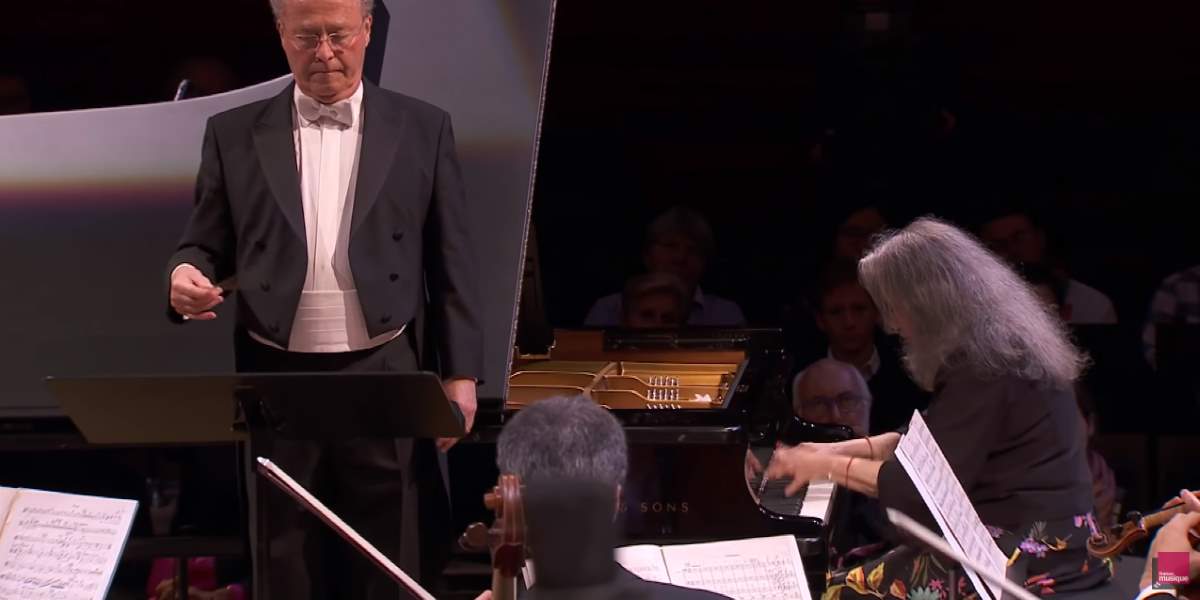Accompanied by the Orchestre National de France, Argentine classical concert pianist Martha Argerich performs Maurice Ravel’s Piano Concerto in G major. Conductor: Emmanuel Krivine. Recorded on July 9, 2022, at the Kolarac Concert Hall in Belgrade.
The piece was composed between 1929 and 1931. It is in three movements and is heavily influenced by jazz, which the French composer encountered on a concert tour of the United States in 1928.
Ravel’s Piano Concerto
The composition of Ravel’s Piano Concerto in G Major is contemporary of his Piano Concerto for the Left Hand, in 1929. The first one is “solar and turbulent” while the second is “dark and desperate” says the musicologist Nicolas Southon.
At the same time poetic, aerial, and formal, the work refers to two masters of piano concertos. In the second movement, Ravel is inspired by the Larghetto of Mozart’s clarinet quintet, the composer who remains the main reference in terms of shapes. He is also influenced by the music of Saint-Saëns, the virtuosity model and pianistic brightness, and by Liszt.
The three movements (Allegramente, Adagio assai, and Presto) make the concerto’s form classic, but the composition is no less modern by its borrowings from jazz, particularly in the two last movements. The Adagio looks improvised, it uses the Blue Note and reminds the symphonic jazz of Gershwin. The Presto mixes jazz and folklore in a frantic race between the piano and the orchestra.
The work is scored for piano and an orchestra consisting of piccolo, flute, oboe, cor anglais, E-flat clarinet, clarinet in B-flat and A, 2 bassoons, 2 horns in F, trumpet in C, trombone, timpani, triangle, snare drum, cymbals, bass drum, tam-tam, wood block, whip, harp, 16 violins, 6 violas, 6 cellos, and 4 double basses.
Movements
I. Allegramente
The first movement opens with a single whip-crack, and what follows can be described as a blend of the Basque and Spanish sounds of Ravel’s youth and the newer jazz styles he had become so fond of. Like many other concerti, the opening movement is written in the standard sonata-allegro form, but with considerably more emphasis placed on the exposition.
At 106 bars in length, the large exposition section contains most of the musical ideas presented in the first movement. After the opening whip-crack and snare drum roll, the piano is introduced, providing a methodical accompanying figure as the winds present the first subject. Soon, the piano stops, and the orchestra roars to life with each section adding to the theme, eventually drifting into an eerie, dream-like statement from the piano. This soliloquy is short-lived as the orchestra reenters with a blues-influenced figure, shifting between major and minor modes. The second subject begins with an awkward dissonance (A♯ and B) but quickly establishes itself as a richly melodic section, reminiscent of Gershwin’s Rhapsody in Blue.
Following a quick chordal passage from the piano, the development begins, utilizing much of the material from the first subject. After progressing through a variety of modes, the music comes to a mystic section played by the harps and strings. Following a short rest, the section continues but is quickly interrupted by a restatement of the “blues section” from the first subject.
An abridged version of the first subject begins the recapitulation, after which a piano cadenza restates the second theme. Through this elaborate restatement, the movement progresses to an energetic coda and ends with a bawdy scale from the brass.
II. Adagio assai
In stark contrast to the preceding movement, the second movement is a tranquil subject of Mozartian serenity written in ternary form. When Long praised the natural flow of the lengthy, seemingly effortless opening melody, Ravel responded: “That flowing phrase! How I worked over it bar by bar! It nearly killed me!”
The first theme is presented solely by the piano, the right hand playing the melody in triple meter (3/4) while the left hand gives a waltz accompaniment (this left-hand waltz accompaniment continues throughout the second movement). After nearly three minutes, a C♯ by solo flute breaks the spell, whereupon the oboe, clarinet,
This second theme is tenser than the first, utilizing dissonant harmonies and figures from the piano. Almost as easily as the theme appears, it fades away into a restatement of the first theme, this time played by the cor anglais while accompanied by rustling ornamentations of the piano. A brief coda brings the movement to a gentle close on a pianissimo trill between B and C♯.
III. Presto
The third movement recalls the intensity of the first with its quick melodies and difficult passage work.
The piano introduces the first subject, a rapid chordal figure, with dissonant interjections from the winds and brass. The subject continues with such interjections from all and progresses through a multitude of modes before finally coming to its conclusion. Here, the movement ends with the same four chords with which it began.

Sources
- Piano Concerto (Ravel) on Wikipedia

